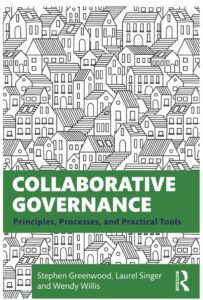By Wendy Willis
 Since the term started emerging in 1970s, collaborative governance has been a wily beast. Just as scholars start to corral and define it, the practice of collaborative governance gallops off in some other direction. Or at least the critter keeps running even as we try to catch our breath and make sense of it. It is in that context that my colleagues and co-authors—Steve Greenwood and Laurel Singer—and I undertook the project of creating a textbook that centers the practice of collaborative governance and attempts to provide students, faculty members, practitioners, project participants, agency leaders, and others with a source to turn to as they wrestle with real-world problems that defy solutions when approached with only traditional governance mechanisms.
Since the term started emerging in 1970s, collaborative governance has been a wily beast. Just as scholars start to corral and define it, the practice of collaborative governance gallops off in some other direction. Or at least the critter keeps running even as we try to catch our breath and make sense of it. It is in that context that my colleagues and co-authors—Steve Greenwood and Laurel Singer—and I undertook the project of creating a textbook that centers the practice of collaborative governance and attempts to provide students, faculty members, practitioners, project participants, agency leaders, and others with a source to turn to as they wrestle with real-world problems that defy solutions when approached with only traditional governance mechanisms.
We—as practitioners and teachers of collaborative governance—were looking for a textbook that started with both feet firmly rooted in practice. So, we wrote one. And we hope that it might be useful to others who find themselves involved in the study or practice of collaborative governance in one of the myriad ways it shows up.
The book—Collaborative Governance: Principles, Practices, and Practical Tools—is organized in three sections: 1) Definitions, Contexts, and Dynamics; 2) Framework and Process; and 3) Skills to Improve Collaborative Governance. The first section attempts to define and describe collaborative governance through the lens of practice. In fact, it defines collaborative governance through six definitional norms that distinguish collaborative governance from both traditional governance and from other types of joint action. It also explores where collaborative governance fits into a constitutional system that prizes the separation of powers and looks with suspicion on the overlap of those powers.
Get notified when new articles are posted to the EDR blog – sign up for our email list »
The second section focuses on the details of collaborative governance processes from start to finish. That section provides a framework for the practice of collaborative governance that follows the process from the assessment all the way through implementation, evaluation, and adaptation.
In the third section, we explore some of the skills and practices that improve the effectiveness of collaborative governance processes. In our experience, not all collaborative governance processes are created equal, and small refinements have big consequences. With that in mind, section 3 both sets forth some of the common issues that arise in collaborative governance cases and explores some of the strategies that participants and facilitators can employ to improve both the process and the outcome.
Finally, the conclusion identifies some of the dilemmas that collaborative governance practitioners are currently contending with, as well as those issues that are just starting to appear on the horizon.
Throughout, we offer examples from our own practice and from that of our colleagues. We look at how collaborative governance has been applied in everything from Western Sage-Grouse conservation to flood mitigation to rural transportation systems. We grapple with how collaborative governance intersects with racial justice and the legacy of white supremacy. We celebrate where collaborative governance projects have succeeded beyond the participants’ wildest imaginings and fret over the places where we all might have done better.
We do end, however, on a hopeful note. We submitted the manuscript almost precisely a year ago, in the midst of a worldwide pandemic, unprecedented wildfires, and a season of racial reckoning. I hope you will indulge me as I quote the last paragraph of the book:
Meanwhile, we write this during one of the most challenging and inspiring summers of our lifetimes—the fissures of political polarization are as deep as they have ever been, wild fires have decimated communities and landscapes in our state and neighboring states, a global pandemic still rages, and demands for racial justice are clear and persistent. So as we look into the future, no outcome is guaranteed. Democracy might be on the ascendency, or it might be on the decline. We need the principles and practices of collaborative governance more than we ever have. We need the theory and practice of collaborative governance to cross-pollinate. We need to build a table devoted to public purposes that is cross-boundary, representative, inclusive, power-sharing, and deliberative, and it is our fondest hope that this book might make a contribution to those efforts.
So that is where I will leave you, too, right in the middle of trying to wrangle the slippery varmint that is collaborative governance. We hope you’ll read the book, introduce it to your students, mark it up, argue with it, add to it, and let us know what is useful and what is not. We hope you’ll share your experiences with collaborative governance in the classroom and in the community. We hope you’ll stay in touch and keep us posted on what you’re learning out there in the rough and tumble of the collaborative governance rodeo.
 Wendy Willis is the founder and director of Oregon’s Kitchen Table, a program of the National Policy Consensus Center in the Mark O. Hatfield School of Government at Portland State University and the Executive Director of the Deliberative Democracy Consortium. Wendy has served as Executive Director of the City Club of Portland, as an Assistant Public Defender for the District of Oregon, and as a law clerk to Chief Justice Wallace P. Carson, Jr., of the Oregon Supreme Court. She is the co-author of the textbook, Collaborative Governance: Principles, Processes, and Practical Tools, as well as the author of a book of essays, and two books of poems. Her most recent two literary books, A Long Late Pledge and These are Strange Times, My Dear, were both finalists for the Oregon Book Award.
Wendy Willis is the founder and director of Oregon’s Kitchen Table, a program of the National Policy Consensus Center in the Mark O. Hatfield School of Government at Portland State University and the Executive Director of the Deliberative Democracy Consortium. Wendy has served as Executive Director of the City Club of Portland, as an Assistant Public Defender for the District of Oregon, and as a law clerk to Chief Justice Wallace P. Carson, Jr., of the Oregon Supreme Court. She is the co-author of the textbook, Collaborative Governance: Principles, Processes, and Practical Tools, as well as the author of a book of essays, and two books of poems. Her most recent two literary books, A Long Late Pledge and These are Strange Times, My Dear, were both finalists for the Oregon Book Award.
